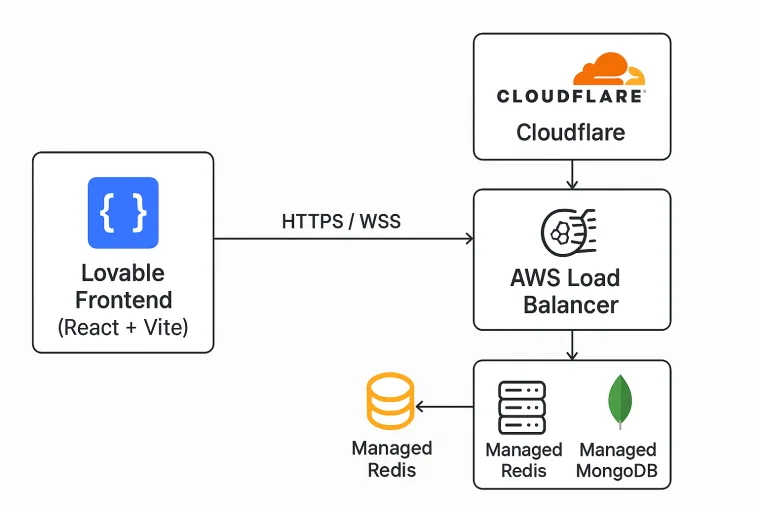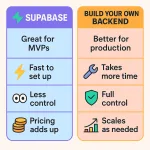Here’s the thing.
Lovable is awesome at building frontends. React, Vite, Tailwind, sprinkle some magic dust on top, and boom, your app looks legit.
But the second you let Lovable manage your backend, you’re basically handing over the keys to your entire future.
It pushes you toward services like Supabase or whatever shiny new thing the product manager at Lovable thought was “good enough.”
And “good enough” is fine until you wake up one day needing a custom query, a new auth flow, or real-time hooks into your database, and suddenly the service you trusted gives you a big middle finger.
Ask me how I know.
The smarter move?
Use Lovable for the frontend.
Spin up your own backend.
Own the whole show.
What Lovable Gets Right (And Where It Tries to Trap You)
First, credit where it’s due.
Lovable nails the frontend game:
- React components out of the box
- TailwindCSS for styling
- Vite for builds
- Easy to export if you want to move it somewhere else
No complaints there. That part works exactly like you want it to.
Where Lovable starts acting shady is when it tries to manage your backend for you:
- Wants you to use Supabase by default
- Encourages API “autogeneration” tied to their schema
- Abstracts your database away behind somebody else’s UI
- Makes changing backend logic basically a hostage negotiation
At first, it feels good.
Fast setup, shiny dashboard, fake sense of security.
Then you realize you can’t do basic stuff like:
- Optimize queries without using their black box plugins
- Customize auth flows unless you hack around defaults
- Scale horizontally without paying triple the normal cloud costs
And if you want to leave?
Better start booking therapy appointments now because unwinding your app from their services is going to hurt.
Vendor Lock-In is a Death March
Picture you build an app with a “friendly” backend-as-a-service. Everything was cool for three months.
Then we needed custom roles and permissions logic. Something super basic like “admins can edit comments, normal users can’t.”
Guess what?
The platform didn’t support it.
Their GitHub issues had been open for two years with devs begging for that feature. Company just responded, “On our roadmap!”
We ended up rewriting the entire backend by hand.
Lost three months of work, torched a client relationship, and had to do a rewrite sprint over Christmas.
Never again.
Moral of the story:
If you don’t own your backend, you don’t own your app.
The Correct Architecture
Here’s what a sane setup looks like:
- Frontend: Use Lovable for your UI and export the code.
- Backend: Use Cursor AI to build a clean Node.js server. You get full Express.js control, real WebSocket server support, and no middlemen.
- Infra: Deploy it smart:
- Frontend: Host your Lovable frontend behind Cloudflare (cheap, fast, protected)
- Backend: Behind an AWS Load Balancer with multiple Node.js servers
- Databases: Managed Redis for pub/sub and caching, Managed MongoDB for your data
Simple flow:
Lovable Frontend (React + Vite)
|
[ Cloudflare ]
|
HTTPS / WSS
|
[ AWS Load Balancer ]
|
Node.js API Servers
/ \
Redis MongoDB
This way you control the frontend, the backend, the data, the scaling, everything.
If you need to change something, you open your code editor, not a customer support ticket.
Quick Example: Backend and Frontend Glue
Node.js Backend
const express = require('express');
const http = require('http');
const WebSocket = require('ws');
const cors = require('cors');
const app = express();
app.use(cors());
app.use(express.json());
// REST API Endpoint
app.get('/api/ping', (req, res) => {
res.json({ message: 'pong' });
});
// HTTP Server + WebSocket Server
const server = http.createServer(app);
const wss = new WebSocket.Server({ server });
// WebSocket Logic
wss.on('connection', (socket) => {
console.log('WebSocket connected');
socket.on('message', (msg) => {
console.log('WebSocket message:', msg);
socket.send(`You said: ${msg}`);
});
});
const PORT = process.env.PORT || 3001;
server.listen(PORT, () => console.log(`Server running on port ${PORT}`));
Lovable Frontend React Component
import { useEffect } from 'react';
export default function ApiTest() {
useEffect(() => {
// API Call
fetch('https://your-backend-domain.com/api/ping')
.then(res => res.json())
.then(data => console.log('API says:', data.message));
// WebSocket Connection
const socket = new WebSocket('wss://your-backend-domain.com');
socket.onopen = () => {
console.log('WebSocket connected');
socket.send('Hello Server!');
};
socket.onmessage = (event) => {
console.log('WebSocket received:', event.data);
};
}, []);
return <div>Testing API and WebSocket. Check console logs.</div>;
}
No magic. No lock-in. No drama.
Pro Tips for Not Screwing This Up
- CORS: Always enable CORS properly on your Node.js backend or your frontend will scream bloody murder.
- Environment Variables: Store your backend URLs and secrets properly. No hardcoded junk.
- Scaling: Start with 1-2 Node servers and auto-scale when traffic ramps up. AWS Elastic Beanstalk is a good “lazy but not stupid” starting point.
- WebSocket Keepalive: Set a ping interval or the connection will die quietly behind load balancers. Trust me.
Final Thoughts
You don’t have to be paranoid to want to own your own backend. You just have to be smart.
Lovable is a frontend generator. Use it like that.
Cursor AI can spin up your backend in minutes.
Control your data. Control your APIs. Control your future.
Because one day you will want to make a tiny change to your API behavior.
And if you gave up control early, your only options will be “live with it” or “rebuild everything from scratch.”
And trust me, nobody ever budgeted enough time for a full rebuild.



